Few things are less appealing than a dog’s bad breath. While a bit of “doggy breath” is normal, a truly foul odor emanating from your canine companion can be a sign of underlying health issues, most commonly dental disease. Fortunately, a crucial part of preventative dental care and breath freshening for your dog can come in a form they’ll love: dental treats. But with countless options on the market, understanding What Is The Best Dog Treat For Bad Breath requires a closer look at their causes, mechanisms, and the key features to prioritize.
This guide will delve into the world of dog dental treats, helping you navigate the choices to find the most effective solutions for your furry friend’s oral hygiene and halitosis. We’ll explore how these treats work, what ingredients and features matter most, and highlight popular options that stand out.
Understanding Dog Bad Breath and Its Causes
Before diving into treats, it’s essential to understand why your dog might have bad breath, or “halitosis.” The overwhelming majority of cases stem from poor oral hygiene and dental disease. Just like humans, dogs accumulate plaque and tartar on their teeth. When food particles, bacteria, and saliva combine, they form plaque, a sticky film. If not removed, plaque hardens into tartar, which is difficult to remove without professional veterinary intervention.
This buildup creates a breeding ground for bacteria, leading to gingivitis (inflammation of the gums) and periodontitis (advanced gum disease), which are not only painful but also release volatile sulfur compounds that cause the characteristic foul smell. Left untreated, severe dental disease can lead to tooth loss and even impact your dog’s overall health, potentially affecting organs like the heart, kidneys, and liver. For dogs dealing with other health concerns like digestive upset or specific dietary needs, choosing the right dental treat becomes even more critical.
How Dental Treats Combat Bad Breath
Dental treats and chews are designed to help reduce plaque and tartar buildup through a combination of mechanical action and specialized ingredients. As your dog chews, the texture and shape of the treat physically scrub the surfaces of their teeth, dislodging food particles and plaque. Beyond this mechanical cleaning, many effective dental treats incorporate additional benefits:
- Enzymatic Action: Some treats include enzymes (like glucose oxidase or lactoperoxidase) that break down bacteria and inhibit plaque formation, even after chewing has stopped.
- Breath Freshening Ingredients: Natural additives such as parsley, mint, and chlorophyll are often included to help neutralize odors and provide immediate breath-freshening effects.
- Unique Shapes and Textures: Intricate shapes and varied textures are engineered to reach more tooth surfaces, including the often-missed gumline, maximizing the scrubbing effect.
- Support for Overall Health: Some formulations also include prebiotics for gut health, which can indirectly support overall well-being and a balanced internal environment.
Key Factors to Consider When Choosing the Best Dog Treat for Bad Breath
Selecting the right dental treat for your dog involves more than just picking a product off the shelf. Here are crucial factors to consider:
- Veterinary Oral Health Council (VOHC) Seal: This is perhaps the most important factor. The VOHC seal indicates that a product meets specific standards for plaque and tartar control in dogs. Products with this seal have undergone rigorous testing to prove their efficacy.
- Size and Hardness: Choose a treat appropriate for your dog’s size and chewing style. Too small, and it could be a choking hazard; too large, and it might not be effective. The treat should be firm enough to provide abrasive action but not so hard that it risks breaking teeth.
- Ingredients and Palatability: Look for natural ingredients and avoid artificial colors, flavors, or preservatives. Real meat ingredients can make treats more appealing. For dogs with specific conditions like pancreatitis-friendly diets or known skin allergies, opt for limited-ingredient or hypoallergenic formulas.
- Calorie Content: Dental treats contribute to your dog’s daily calorie intake. Be mindful of this to prevent weight gain, especially for dogs who might also enjoy regular treats like dehydrated beef liver treats.
- Daily Use vs. Occasional Supplement: Some treats are designed for daily use to maintain oral hygiene, while others might be more suitable as occasional supplements. Follow the manufacturer’s recommendations.
Top Types of Dog Treats and Products for Bad Breath
Based on their effectiveness and popular features, here are the main categories of products that are excellent choices for tackling dog bad breath:
1. Enzymatic Dental Chews & Systems
These products combine mechanical chewing with enzyme technology for a powerful plaque-fighting punch.
BARK Bright Dental Kit
This innovative system pairs a unique star-shaped dental chew with a triple-enzymatic toothpaste. The chew’s design helps distribute the toothpaste as your dog chews, allowing the enzymes to break down plaque-causing bacteria effectively. Each kit provides a month’s supply, features real chicken, and uses ingredients sourced from the USA and Denmark. This system offers a unique “no-toothbrush” solution for daily dental care.
2. Textured Dental Chew Toys
For dogs who love to chew but you prefer a non-consumable option, durable dental chew toys offer significant benefits. These toys are designed with textures and shapes that help scrape away plaque.
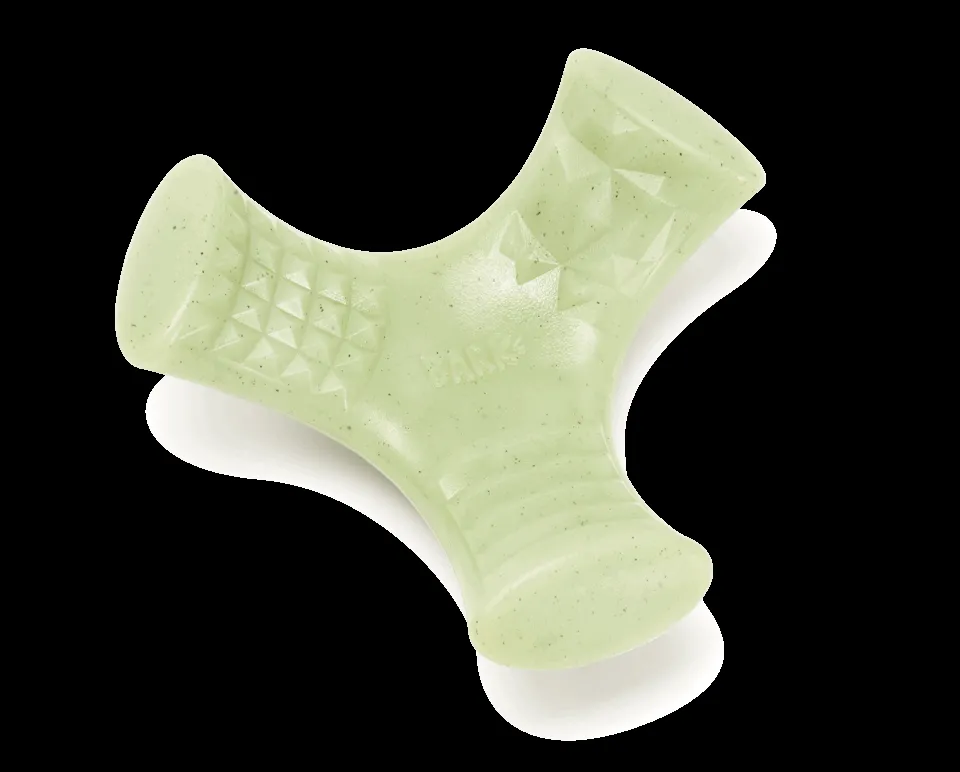 Dog chewing on a Super Chewer "Chopper" chew toy
Dog chewing on a Super Chewer "Chopper" chew toy
Super Chewer “Chopper” Chew
This mint-scented, nylon-infused chew toy provides excellent mechanical plaque removal. Its three-pronged shape engages teeth from multiple angles, making daily dental care feel like playtime. You can even enhance its effect by applying an enzymatic toothpaste to the toy’s surface with a cotton pad. Multiple sizes ensure a fit for various dog breeds.
BARK Bright Dental Tool
This “toy” is specifically designed to be paired with enzymatic toothpaste. Its natural rubber bristles and toothpaste reservoirs help scrub both top and bottom teeth, dispersing the enzymes for a thorough clean. It’s vanilla-scented for appeal and features a rocking motion for engaging play, making toothbrush time less of a chore.
3. Plant-Based & Limited Ingredient Chews
Ideal for dogs with food sensitivities or owners looking for meat-free options, these treats often feature unique shapes for enhanced cleaning.
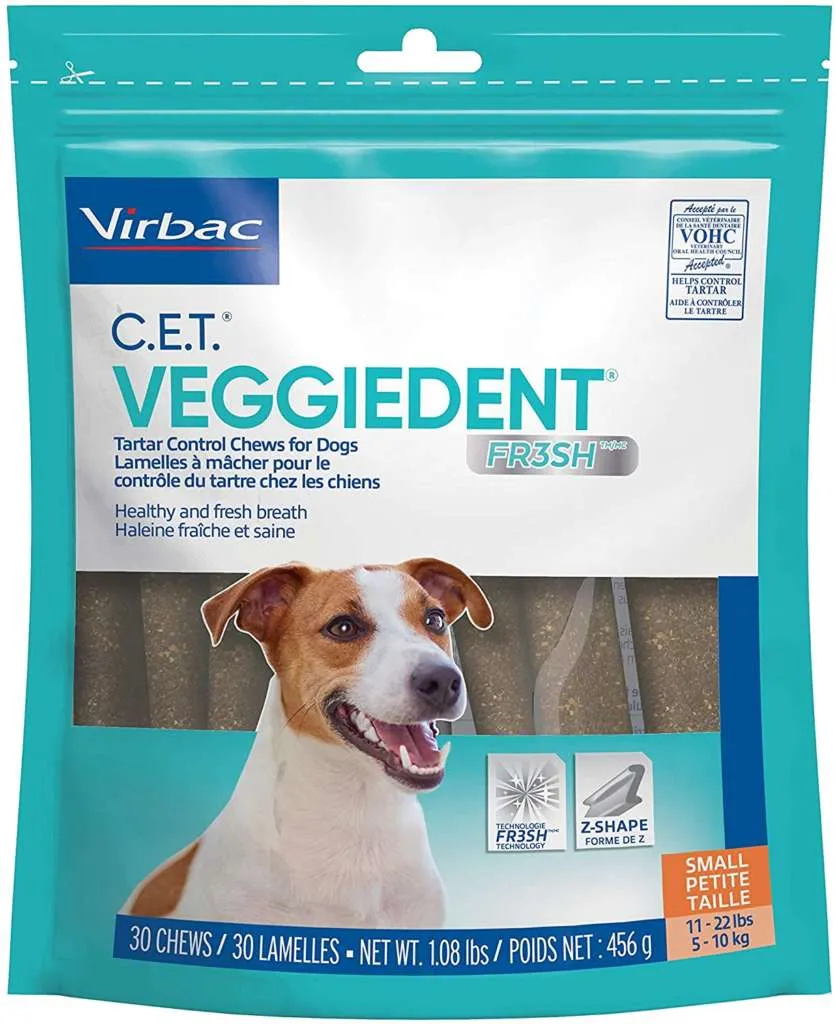 Virbac C.E.T. VEGGIEDENT Tartar Control Chews in a package
Virbac C.E.T. VEGGIEDENT Tartar Control Chews in a package
Virbac C.E.T. VEGGIEDENT Tartar Control Chews
These plant-based chews are soft enough for chewing yet robust enough to tackle plaque. Their distinctive Z-shape allows for greater tooth surface contact, boosting cleaning benefits and freshening breath. They also contain a prebiotic to support gut health and digestion, making them an excellent choice for sensitive tummies.
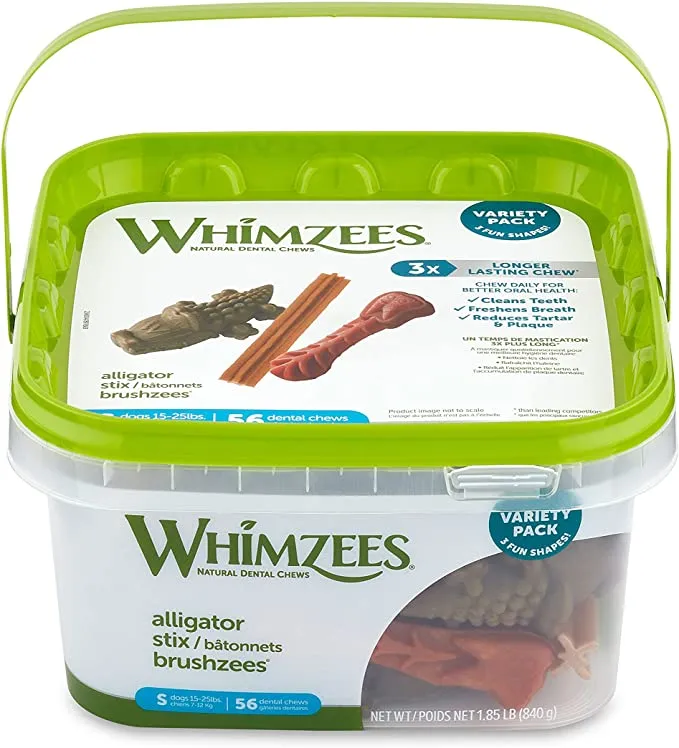 Whimzees All Natural Dental Chews in various fun shapes
Whimzees All Natural Dental Chews in various fun shapes
Whimzees Natural Dental Chews
Whimzees offer all-natural, non-GMO, vegetarian dental chews in a variety of fun shapes and textures. These unique designs effectively clean away plaque and freshen breath. Being meat-free, they are particularly suitable for dogs with food allergies or sensitivities, offering a delicious and effective solution.
4. Flavored & Scrubbing Chews
These popular choices combine appealing flavors with effective scrubbing action, making dental care a treat your dog looks forward to.
Benebone Dental Chew
Designed with a curved shape for easy gripping, the Benebone Dental Chew encourages productive chewing. Infused with real bacon flavor, it keeps dogs engaged. It features textured ridges for enhanced scrubbing, promoting cleaner teeth and fresher breath. While highly effective, it’s important to remember this is a non-edible chew and should be replaced if your dog attempts to consume it.
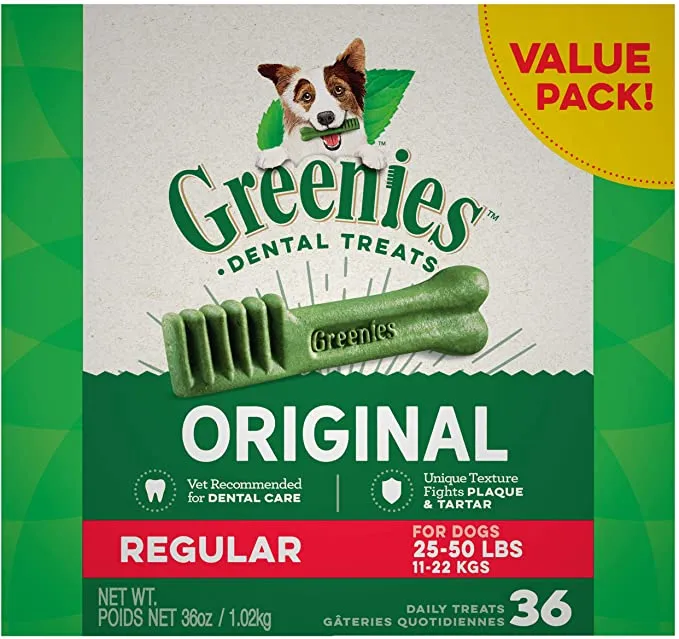 Package of Greenies Regular Dental Dog Treats
Package of Greenies Regular Dental Dog Treats
Greenies Dental Treats
Greenies are widely recognized for their unique toothbrush shape and chewy texture. These treats fight plaque buildup through daily chewing, using natural, easily digestible ingredients. Fortified with vitamins and minerals, they offer a holistic approach to oral health, designed for consistent daily use.
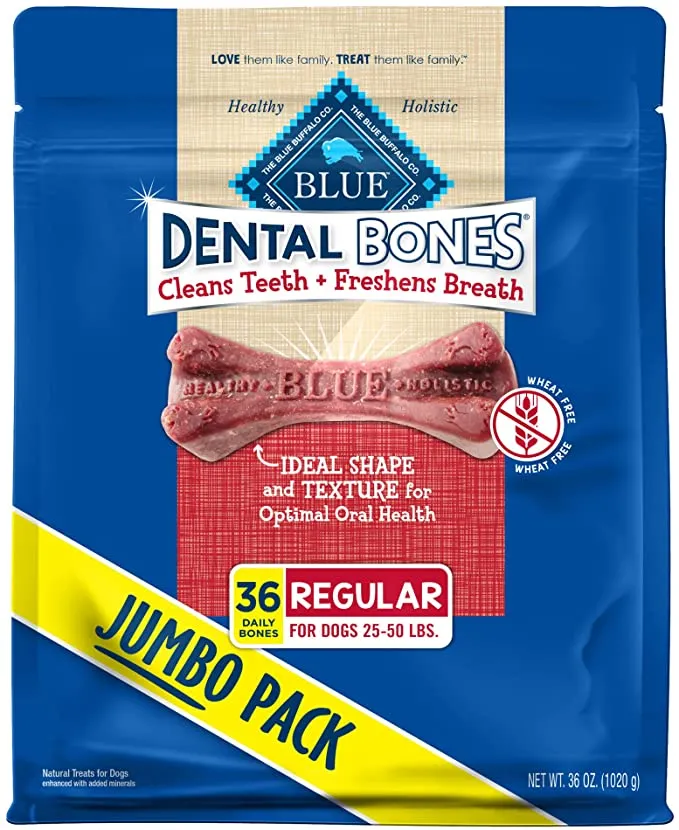 Blue Buffalo Dental Bones in a resealable bag
Blue Buffalo Dental Bones in a resealable bag
Blue Buffalo Dental Bones
These dog bone-shaped dental treats are formulated for both taste and oral health. They are free from poultry by-product meal, corn, wheat, or soy, making them a cleaner option. Enriched with parsley for fresher breath and peas and blueberries for digestion, their unique shape and chewy texture contribute to effective plaque removal. For senior dogs with conditions like arthritis pain management, softer dental chews can be a more comfortable option.
When Do Dogs Need a Professional Dental Cleaning?
While dental treats are excellent for preventative care and maintaining good oral hygiene, they are not a substitute for professional veterinary care. If your dog already has significant plaque and tartar buildup, dental treats alone won’t solve the problem. A professional cleaning under anesthesia by a veterinarian is necessary to remove hardened tartar, address gum disease, and ensure a healthy starting point.
Signs that indicate a professional veterinary dental assessment is needed include:
- Persistent, very bad breath despite home care
- Swollen, red, or bleeding gums
- Visible tartar (brown or yellow buildup on teeth)
- Broken, loose, or discolored teeth (dark brown/black)
- Loss of appetite or difficulty eating
- Abnormal drooling or difficulty swallowing
- Reluctance to chew on toys or treats
Always consult your veterinarian if you have concerns about your dog’s oral health. They can accurately diagnose any issues and recommend the most appropriate course of action, which may include professional cleaning or other treatments.
Conclusion
Choosing what is the best dog treat for bad breath involves understanding your dog’s specific needs, the causes of their bad breath, and the various mechanisms by which dental treats work. By incorporating VOHC-approved products, considering ingredients and sizing, and combining treats with a consistent oral hygiene routine, you can significantly improve your dog’s breath and overall dental health. Remember, dental treats are a valuable tool, but regular veterinary check-ups remain paramount for your dog’s long-term well-being. A fresh breath is not just pleasant; it’s a strong indicator of a healthy, happy dog.
